Estelada
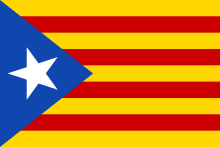
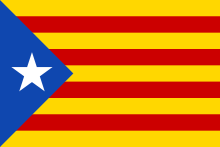

The Estelada (Eastern Catalan: [əstəˈɫaðə], Western Catalan: [esteˈlaða]; pl. Estelades; full name Senyera estelada, "starred flag" or "lone star flag", from estel, "star") is a non-official flag typically waved by Catalan independentists to express their support for an either independent Catalonia (Spain) or independent Països Catalans (Catalan Countries, i.e. the territories where Catalan is traditionally spoken). The usage of this flag as a protest token within Catalan nationalism has become more apparent ever since the 1970s Spanish transition to democracy. The Estelada pattern is that of the Senyera but with the addition of a five-pointed star in a triangle.
Design and meaning

The flag dates from the early 20th century, most probably designed in 1918 by Vicenç Albert Ballester i Camps.[1] It was born from the fusion of the four traditional red stripes of the Senyera with a triangle containing a star, inspired by the flags of Cuba and Puerto Rico.
History
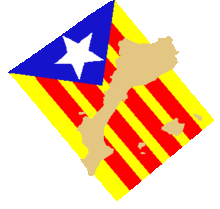
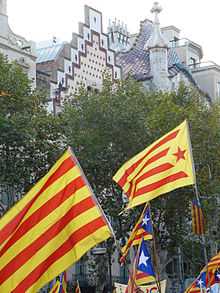
The 3rd Article of the provisional Constitution of the Catalan Republic, written and approved in 1928 in Cuba by the Assemblea Constituent (Constituent Assembly) of Catalan separatism, specifically provides that the official flag of the Catalan Republic consists of four red bars on a yellow field, superimposed with a blue triangle and white five-pointed star.
The star in the fighting flag comes from the early days of nationalism. The lone star means national freedom and independence. Cuba's fight for its independence was followed with attention by the Catalanists of the nineteenth century. Once the Cuban War of Independence ended, in 1906, the Centre Catalanista de Santiago de Cuba (Catalanist Centre of Santiago de Cuba) was created, where one could already see the primitive Catalan estelada flag: in the middle of a senyera there was a white star with five points.
The first star with a clear nationalist intention known in Catalonia is of a date before 1904, and it has to do with the Unió Catalanista (Catalanist Union). It is a stamp commemorating the ownership process of Pi de les Tres Branques (The Three-Branched Pine) by the Catalanist Union.
Later, in 1906, a star appears in the headers of the magazine Fora Grillons! (Breaking Chains!), made in Santiago de Cuba by Catalan exiles (a publication that already claimed clearly the independence of Catalonia).
During the twenties, once the First World War is over, Europe sees a wave of creation of nation-states, helped by the American president Woodrow Wilson.
The politics of the League of Nations allowed many nations to see their historical opportunity to free themselves, and so did Czechoslovakia, Finland, Estonia, Latvia, Lithuania and Armenia during the year 1918; other nations like Ukraine, Belarus and Georgia, were declared independent but occupied by the Soviets straight away.
In all these nations that have the hope of freedom, pressure groups start to mobilize in international spheres. In the Catalan case, the Comitè Pro-Catalunya (Pro-Catalonia Committee) was one of the most active. It was in these circumstances that a need was seen to have a symbol able to represent the Catalan aspirations and, of course, a star appeared on it.
It was since then that one started to hear about the estelada flag. Its design is, probably, of Vicenç Albert Ballester, where the blue triangle signifies the blue sky of humanity, and in its centre, the white star symbolizes freedom.
The first photograph where the flag appears is in a publication dated in 1918. It is the bulletin L’intransigent (The Intransigent), where a photo is reproduced of a group of young Americans and Catalan independentists holding both flags.
Also in 1918, there is in circulation a comic strip—a stamp without postal value—dedicated to the future Society of Nations, where there was also an estelada.
There are several kinds of estelada. One is in the last number of La Tralla (a radical separatist magazine from the 1920s), before the coup d'état by Miguel Primo de Rivera. The other is in a document published by the Comitè Pro-Catalunya written in Catalan and Arabic, to greet and encourage one of the Moroccan leaders who revolted against Spain.
In Cuba, appears for first time the headers of the magazine La Nova Catalunya (1920), (The New Catalonia).
The estelada flag goes on to appear in other Catalan independentists publications.
The estelada was in the possession of Francesc Macià during the failed invasion of Prats de Molló in 1926. It appears between the Catalan volunteers in prison and the time when they were taken to Paris to be put on trial. There are also photos of the volunteers with the estelada in many other different places.
In 1928, with the presidency of Francesc Macià in the Constituent Assembly of the Catalan independentism, the estelada is again with them, and the Catalan independentists make it theirs.
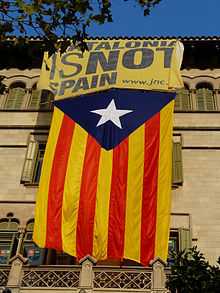
During this period a new habit starts and it is present until those days. Every time a prominent Catalan nationalist dies, in a sign of grievance, his comrades cover with a black cloth the part in the estelada with the four bars of the Catalan flag, leaving the star visible as a sign that they will continue pursuing the same ideals.
Later, during the period from 1931 to 1936, the estelada still appears numerous times. Some of these flags only have two colours due to the shortage of money, but the traditional estelada with the blue triangle and white star was kept.
After the Francoist dictatorship came to power, the Front Nacional de Catalunya (National Front of Catalonia), or FNC, which used the Catalan flag and the estelada, is formed as an answer to the new Spanish nationalist regime.
During the sixties, in the university section of the FNC, there was a split named Partit Socialista d’Alliberament Nacional dels Països Catalans, (Socialist Party for the National Liberation of the Catalan Countries), or PSAN. Because this party wanted to make its own socialist and Marxist ideas clear, it decided to change the colour of the star to red. So, in 1969, a new version of the estelada started to appear at PSAN meetings.
In the mid-seventies, the PSAN had, in turn, its own splits. They led to the creation of a new movement, the Moviment d’Unificació Marxista (Movement of Marxist Unification), which started to use the red star inside a white triangle, while the PSAN kept the red star inside a yellow triangle.
The unification of the two verions of the flag only could take place when the Movement of Marxist Unification and the Bloc d’Esquerra d’Alliberament Nacional (Bloc of the Left for the National Liberation), or BEAN, both disbanded. At that time the flag with the red star and the yellow triangle were the symbol of the socialist and communist independentists.
Present-day use
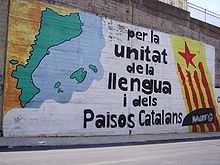
As of 2005 both kinds of Estelada flag (the classic and the red) are used at the same time.
After the Fall of Communism in Europe the red star of the Estelada groga (yellow estelada) has lost steadily its original leftist meaning. Presently it is flown merely as a less color-cluttered, simpler Estelada version in the traditional Catalan colors.
The estelada is ubiquitous as a simplified symbol, four vertical bars topped by a star, sprayed or daubed on walls, lampposts or mailboxes all over Catalonia. These simple (and often vandalistic) graffiti are most often in one basic color, either in black or red. More elaborate large pro-independence graffiti use often the red-star Estelada as a symbol.
Valencian nationalist Senyera
The Valencian nationalist Senyera, also known simply as Estrelada, is a flag of Valencia that evolved from the flag of Valencia city based on the former Catalan Estelada.
The white star version is used by Valencian nationalist groups since the early 20th century. Some of these groups may even be of blaver ideology, especially those with more pro-sovereign positions.
The oldest conserved document with a reference, with a red star, is a war poster of Valencian Left.
Other Estelades
 |
 |
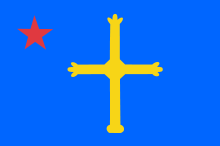 |
 |
 |
|---|---|---|---|---|
| Aragon | Galicia | Asturias | Canary Islands | Andalusia |
Since its creation, different Estelades, or Estrelades, have been adopted by independentist movements in Spain; such as the Andalusian, Aragonese or Galician separatist flags.
References
- ↑ Vicenç Albert Ballester i Camps Grup Enciclopèdia Catalana
Further reading
- Joan Crexell i Playà, L'origen de la bandera independentista, Edicions El Llamp, 1984.
External links
| Wikimedia Commons has media related to Estelades. |
- (Catalan) 100th anniversary of estelada flag
- (Catalan) History of the estelada flag
- (Catalan) Estelades gallery

.svg.png)